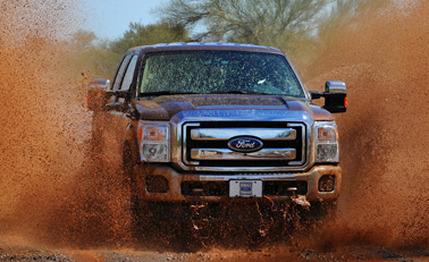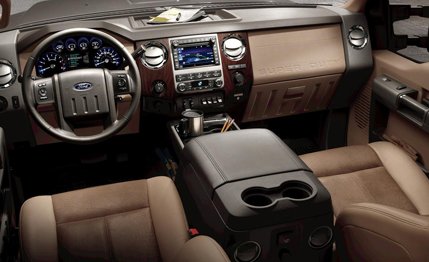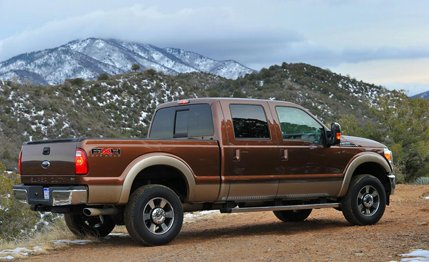
 First Drive Review
First Drive Review
Say what you will about refinements and trick features, the keys to success in the heavy-duty pickup business are power and payload. This is not to say that Ford has nothing to say in the area of civilizing niceties—quite the contrary. But the big story surrounding the blue oval brand’s 2011 F-series Super Duty trucks has to do with a major uptick in muscle and work ethic.
When the new big boys—the F-250, the F-350, and the F-450—swagger into showrooms in April, they’ll sport two new engines, a new six-speed automatic transmission, the biggest payload capacities in their respective categories, and the highest towing capabilities. That’s not to mention the fresh sheetmetal and a grille with a pair of big, shiny horizontal bars reflective enough to be seen from low-earth orbit.
It’s big iron with a big curbside presence. And with a new 13-inch blue-oval logo up front, it would require extremely poor eyesight (apologies to Stevie Wonder) to perceive this as anything but a Ford.
The Power Play
The two new engines are a 6.2-liter gasoline V-8 and a 6.7-liter turbo-diesel V-8. Ford’s SOHC 6.8-liter V-10—362 hp, 457 lb-ft of torque—carries over but is limited to chassis-cab applications.
Rated for 385 hp and 405 lb-ft, the gasoline V-8 is a short-stroke, over-square SOHC 16-valve design with variable cam timing and two spark plugs per cylinder to ensure more complete combustion. It’s capable of running on E85 and replaces the rather anemic 5.4-liter V-8 that registered a mere whimper in the full-size-truck segment with 300 hp and 365 lb-ft. We can’t wait to see what Ford’s F-150 SVT Raptor, currently the only light-duty application for the engine, can do with one of these 6.2-liters bolted under its hood.


The bigger news is the new turbocharged and intercooled 6.7-liter Power Stroke diesel V-8. Not only does it generate output ratings that make competing oil burners look tame—390 hp and 735 lb-ft—but it also produces these numbers at very low revs (2800 and 1600 rpm, respectively). Moreover, it represents a clean-sheet—or, more accurately, a blank-computer-screen—design by Ford, and it can burn B20 biodiesel.
After a long and sometimes rancorous relationship with Navistar, Ford’s previous diesel-engine partner, the automaker elected to develop the next generation of its Power Stroke diesel in-house. Bosch worked with the Ford team to develop the turbo system, which entails an innovative variable turbo: one turbine wheel (supplied by Honeywell) with vanes on both sides, operating sequentially. Another intriguing design element is the absence of external exhaust headers. Airflow through the heads is reversed, with air entering on the outside and the exhaust ports and turbocharger inside the engine’s V. This allows for shorter plumbing and improves turbo response time and cooling. Like other contemporary common-rail diesels, injection pressures are enormous—close to 30,000 psi—to enhance fuel atomization and promote more-complete combustion. Even so, reducing oxides of nitrogen and particulates to meet emissions regs for all 50 states requires a significant 30 to 50 percent of the exhaust gases to be recirculated, plus urea injection upstream from the catalytic converter and a particulate filter at its exit.
In addition to several other inventive elements, Ford claims its new engine weighs 160 fewer pounds than the Navistar 6.4-liter V-8 it replaces, thanks to aluminum cylinder heads and the use of a compacted-graphite-iron block.
Prodigious Performance
Developed for the higher output of the new turbo-diesel, Ford’s heavy-duty 6R140 TorqShift six-speed automatic transmission is equally new, replacing the previous five-speed automatic as well as the six-speed manual, which has been dropped. The 6R140 serves gas and diesel trucks. Its shifts are smooth, and manual-operation options extend to electronically locking out some of the higher gears to prevent upshifts in heavy-load situations, thus keeping the engine in the sweet spot of its power band.
The combination of the new turbo-diesel and six-speed auto adds up to performance that is nothing short of prodigious. This doesn’t refer to 0-to-60-mph times, of course—vehicles weighing anywhere from just under three to well over four tons aren’t quick off the line unless there’s a catapult involved, and in any case, diesels usually aren’t the right prescription for drag strips.
But when it comes to work, these babies deliver. The most impressive part of a day-long preview staged by Ford involved hitching an F-250 Super Duty crew cab to a 10,000-pound trailer and then towing it up and down a mountain loop. The Power Stroke diesel handled the job easily and with astonishingly little racket.
Towing capabilities range from a claimed 11,800 pounds up to 16,000 with a frame-mounted hitch and up to 24,400 pounds with a gooseneck or fifth-wheel setup, which for the first time is a factory-installed option. Maximum payloads range from 2350 pounds to as high 6520, and Ford claims best-in-class in both categories across its broad range of heavy-duty offerings.
Beyond that, Ford says the new turbo-diesel, in addition to its increased muscle, will deliver up to 18 percent better fuel economy (15 percent for the new gasoline V-8). What this means precisely is hard to quantify, since the EPA doesn’t issue ratings for vehicles with gross vehicle weight ratings above 8600 pounds. But we’d anticipate unladen fuel economy in the low-20-mpg range on the highway, depending on axle ratio.
Deliberate Dynamics
Aside from heftier crossmembers and beefed-up steering gear, the trestle-like underpinnings of the Super Duty trucks are unchanged. The suspension design—control arms and coils up front (a solid axle in four-wheel-drive models), longitudinal leaf springs and a solid axle at the rear—is also carry-over, although the shocks have been revalved and retuned to provide a cushier ride.
The ride does in fact seem velvety—on smooth pavement. But the first significant bump reminds you that there are substantial masses of unsprung weight moving around down there. This is, after all, a big truck; no one is going to confuse it with a Mustang. Similarly, the steering, designed to deal with immense loads, is slow and not at all tactile. The effort is about right, but on-center feel is simply not a part of the deal.


On the other hand, cabin noise has been reduced compared with that of the previous Super Duty, in part due to the remarkably quiet operation of the new turbo-diesel engine, but also thanks to the isolation of pavement resonance coming up through the suspension. We also were impressed with the truck’s off-road capability, enhanced by a hill-descent-control feature and lockable rear diff. A long wheelbase isn’t the best bet for rock crawling, but the Super Duty does seem to be well suited to getting contractors to remote job sites.
The Inner Mastodon
Perhaps the biggest physical update to the inner Super Duty is up front, where the seats from the latest F-150 have been carried into the bigger trucks. There’s an immense center console capable of swallowing your pet badger—or at least a couple of laptops. And the dashboard has been redesigned.
And of course there’s a plethora of electronic goodies on offer: stability control; an updated edition of Sync, Ford’s Microsoft-based communications and infotainment system; an optional touch-screen nav system; an LCD for tracking fuel economy, trip time, miles to empty, etc.; a pre-towing checklist; and the Ford Work Solutions feature that includes an in-dash computer and an RFID system to keep track of tools and equipment.
The Bottom Line
When the 2011 Super Duty trucks go on sale in April, pricing for a base two-wheel-drive standard-cab F-250 with the 6.2-liter V-8 will start at $28,975, a noticeable increase over its predecessor, which based at $26,850.
But Super Duty increases aren’t uniform across the board, and there are bright spots, such as the F-250 four-wheel-drive XLT crew cab at $37,940, which is the same as the corresponding 2010 version and includes the new automatic transmission, since the manual transmission has been discontinued. With such a broad lineup of models, heavy-duty pickup prices span a wide range, and that’s true here, from the base truck’s to more than $64,000 for a burly F-450 with all the trimmings.
Given the nature of these beasts, their appeal is limited largely to buyers who need big capabilities. Ford currently owns 46 percent of this total market, 65 percent of which is diesel. A large component of the total market is fleet and commercial users, and Ford claims 60 percent of that. The aim, of course, is to increase share right across the board. Judging by our brief encounter with the lineup, it looks like Ford has the right weapons for the fight.